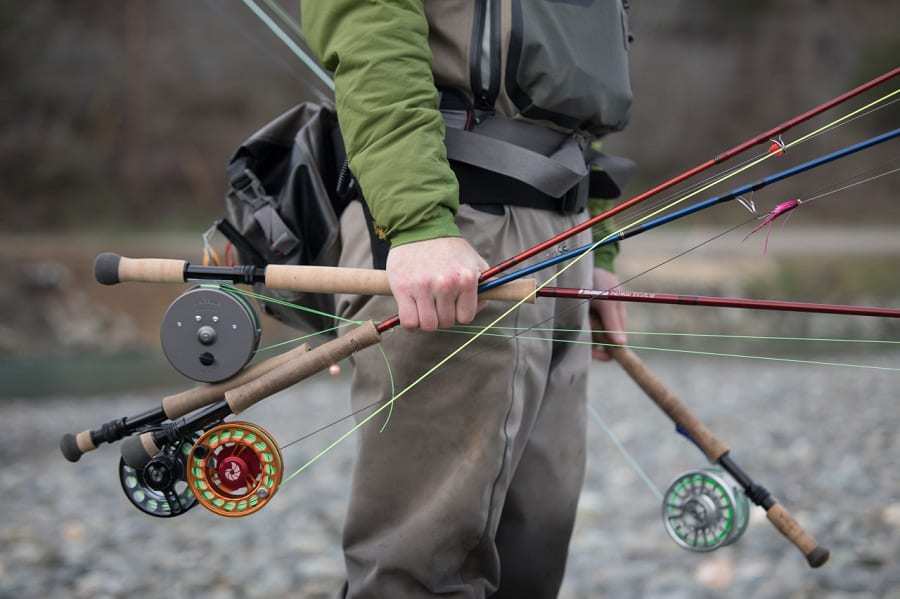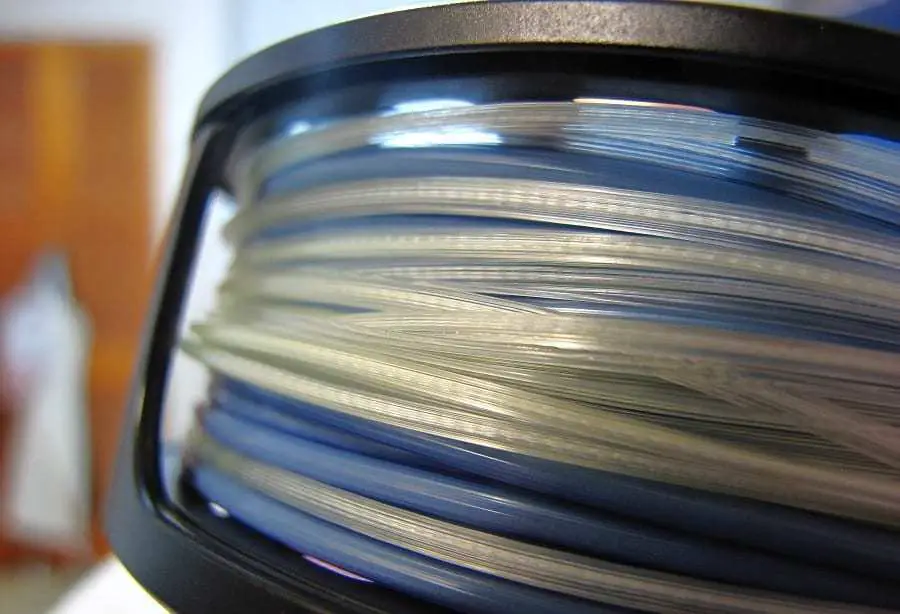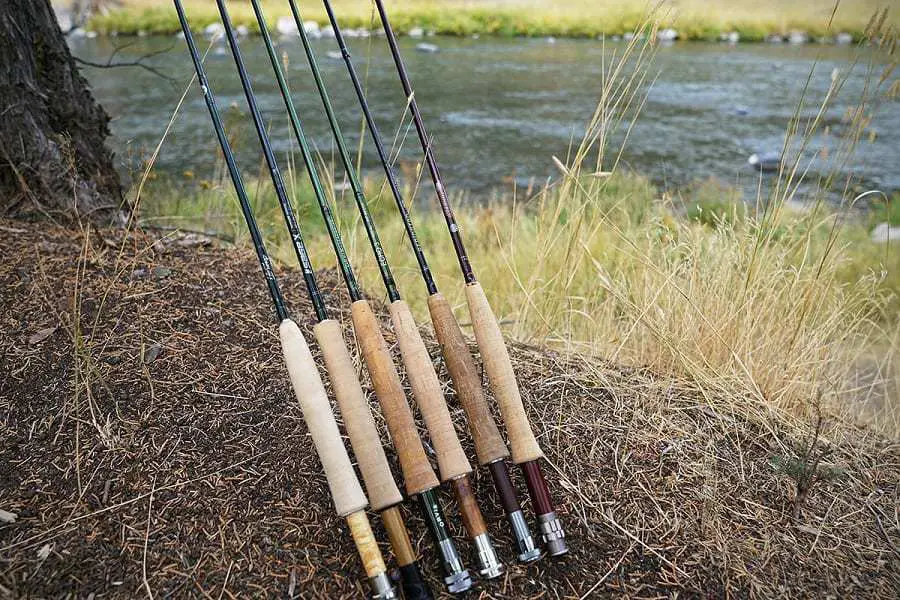Choosing the right fly line for the job is going to affect whether you will be landing fish or just working on your cast.
If you plan on fishing for rising trout with dry flies then a sinking line isn’t going to do you any favors. If striped bass are forming a blitz 80 feet offshore and you can only cast your floating line 60 feet, you will be a tortured human being.
That’s why Kempoo brings you the breakdown on fly fishing lines.
The right fly fishing line selection is going to depend entirely on what you intend to accomplish with that fly line.
What Is Fly Line Weight?

I had a brief experience at a fly fishing only stream when I was about 7-8 years old. Unfortunately, I didn’t have a fly rod at the time, but I figured I’d better follow regulations.
In the spirit of fly fishing, I tied a streamer fly onto my spinning rod and reel setup. Things went downhill from there.
With the breeze blowing straight back in my face, not one cast put the fly past 8 feet out. But I learned a valuable lesson that all fly anglers must eventually learn.
Unlike spin casting a lure, flies do not weigh enough by themselves to carry any forward momentum. When we cast a fly, we are really casting the fly line. The momentum of the fly line is what carries the fly through the air.
LINE WEIGHT EXPLAINED
Manufacturers rate their lines by their weight, which is decidedly a confusing term. The line weight does not refer to how much the line actually weighs. Rather to what weight of fly fishing rod it is meant to be paired with.
The size of the fish you are after will dictate what weight fly rod you will need. And since the fly line pairs with the fly rod, the weight of the fly rod will then dictate what line weight you will need.
On other words, in order to decide what weight fly line you might need, you first need to know what weight fly rod you need.
WHICH WEIGHT FLY ROD?
Fly rods in 1-3 weight are well suited for small trout or panfish.
Rods in 4 weight are also effective for panfish and medium size trout. General purpose rods are those in the 5 and 6 weight varieties.
Rods in 7 weight are popular for large bass fishing, steelhead, and salmon fishing. Fly rods in 8 weight and above are practical for larger species and salt water fishing.
What Types Of Fly Fishing Lines Are There?
The fly fishing line isn’t all that complicated. In fact, it’s really simple stuff.
But like any tool you will only get the greatest benefit from it when you know how to apply it. Simply put, fly lines either float, sink, or sometimes they do both.
FLOATING LINE
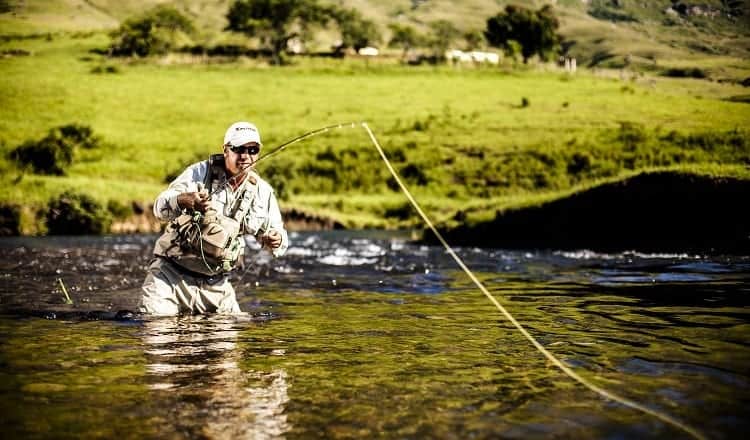
Every angler I’ve ever known loves to see their fly do a toilet-bowl-style flush into the mouth of a big rising fish. The popularity of dry fly fishing and top-water fishing has buoyed the popularity of floating lines as well.
But floating fly lines are very useful in other applications.
Whether in rivers and lakes or the Saltwater and surf, floating fly fishing lines are the most dynamic and widely applied of the fly line varieties. If you are only able to buy one fly line, make it a quality floating line. You can read all the details about our top floating fly line choices.
FLOATING FLY LINE APPLICATIONS
Floating lines help to keep the fly on or near the surface in most cases.
With that said, nymph fishing is likely the second most popular use for floating fly lines. The importance of drag-free drift while fishing with dry flies translates into nymph fishing as well.
Since Nymph fishing usually involves a strike indicator, some lines have integrated a brightly colored high visibility section where the line meets the leader.
Floating fly fishing lines provide an excellent platform for drifting a size 18 Pale Morning Dun across a calm pool as well as trickling a size 14 yellow stonefly along a sandy streambed.
Fishing streamers and wet flies with floating lines will bring fish to the net as well. This is admittedly not the mainstream approach.
But sometimes an unconventional approach can be the ticket to successful fishing. After all, that old fisherman that somehow always sets into a monster fish doesn’t use the same methods as everyone else. Successful fly fishing is all about odd little subtleties that just work.
SINKING LINE
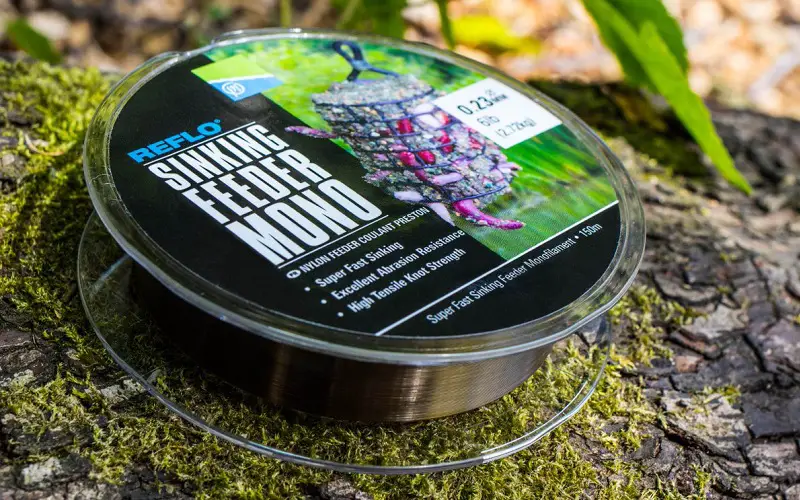
If you don’t see any fish feeding on or near the surface, don’t be fooled into thinking that they are not feeding at all. Studies of fish behavior show that a huge majority of fish feeding behavior occurs underwater.
Some of the best fishing I’ve ever experienced was while fishing a fly well beneath the surface, often between 5-10 feet deep. And nothing presents a wet fly at a consistent depth like a full sinking line.
Sinking lines carry the fly down to a desired depth. These lines sink at specific rates as indicated on the manufacturer’s packaging. The sink rate is measured in inches per second, or ips.
When fish are feeding at a specific depth the sinking fly fishing line can prove very effective.
Anglers most regularly use sinking fly fishing lines in lakes and ponds with great success. You can read all the details about our top sinking fly line choices.
INTERMEDIATE LINES
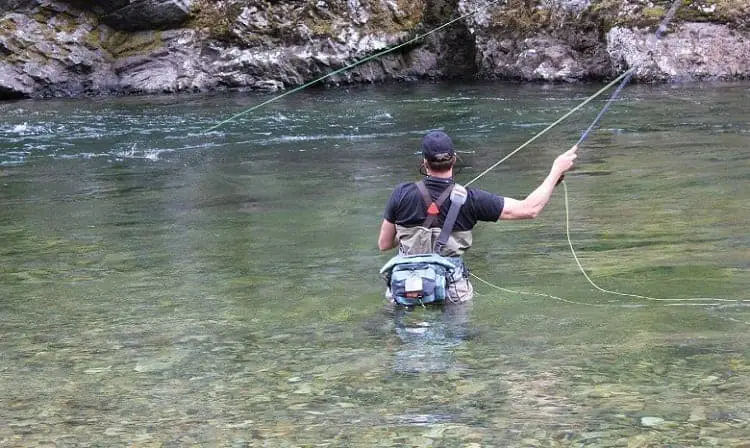
Intermediate lines are a type of very slow sinking line with sinking rates around 1-2 inches per second (ips). There is no market standard for intermediate line sink rates either.
One manufacturer might make an intermediate line that sinks at 1 inch per second, but another might sink 2.5 inches per second.
Intermediate lines are great for fishing with a slow retrieve. Certain fish foods linger just below the surface and present an appetizing opportunity for prowling fish. The slow sink rate prevents the fly fishing line from sinking too quickly and causing the fly to hook the bottom or tangle with debris.
With faster retrieves intermediate lines are excellent if you want to keep the fly in the upper water column.
These are perfect lines for fishing shallow saltwater flats or retrieving bait fish imitations near the surface. You can also jump over to our selections for the best intermediate fly line.
SINKING TIP

Sinking-tip lines have a section at the tip of the line that sinks while the rest of the line floats. This section usually measures somewhere between 8-20 feet, and like a full sinking fly fishing line, the sinking tip sinks at a rate given in inches per second.
These lines are well suited for fast-moving rivers and moving water where you need to get the fly down quickly before it passes through the pool.
While sinking tip lines are applicable in lakes and ponds, they are particularly effective when paired with the right streamer fly in deep river pools.
Since only the tip sinks while the remainder of the running line floats, you can prevent fly line from sinking around your feet and tangling around your boots, and snagging on debris. Read more about the best sinking tip fly lines.
What Type Of Fly Line Taper Do I Need?
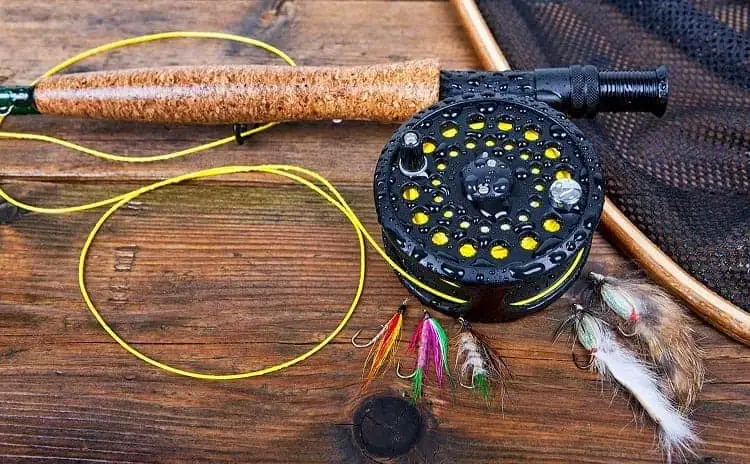
Manufacturers have integrated tapers into their fly fishing line designs to enhance casting.
Fly line tapers vary slightly and each manufacturer puts their own touch into their designs. Some details simply come down to preference and others do not. We will sort all that out, so don’t feel flustered.
While some anglers might like heavy lines that provide for extreme distance casting, other anglers might need an incredibly gentle presentation.
If you slap the water over selective fish that are easily spooked, they will bolt. Manufacturers design lines specifically for these various applications.
Fly line labeling can be confusing, featuring numbers and letters like WF5F, and WF8S6. You really need to understand what these designations mean before making a purchase.
The correct taper of the fly fishing line will provide benefits that sway the odds in favor of a successful and memorable day on the water.
WEIGHT FORWARD LINES
Weight forward lines have a slow taper that gradually becomes thicker toward the casting end. The weight forward taper is the most common floating line. It works great for a wide variety of fishing.
Weight forward lines tend to cast easier because the weight of the line is shifted toward the casting end. Weight forward tapers carry the thicker and heavier section in the last 40-50 feet of line.
The line then tapers down once more to transfer energy down the line and ultimately turn over the fly.
Packaging will indicate a weight forward line with the letters WF.
If the packaging reads “WF5F” then you are looking at a weight forward 5 weight line that floats. WF5S would indicate the same taper and weight, but in this case, the line would sink.
The fly fishing line you purchase needs to be matched to the rod weight.
But some manufacturers label their rods with a 5/6 designation. This means the rod can be paired with either a 5 or 6-weight line. Which particular line weight feels better to cast with that rod is up to the angler to decide.
DOUBLE TAPER LINES
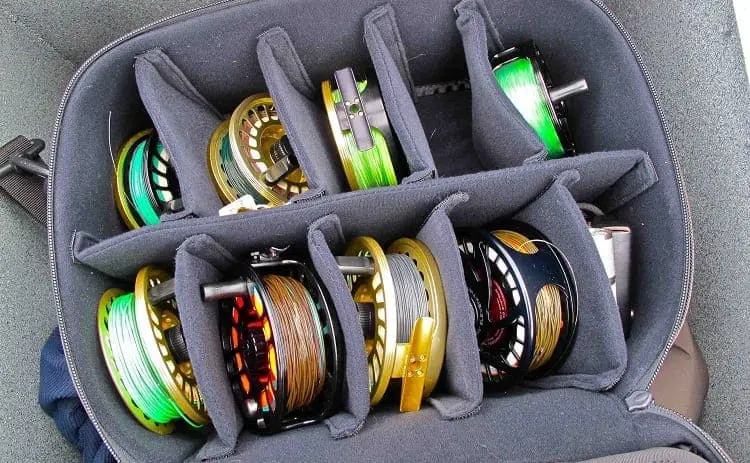
Double taper lines are another popular taper.
Packaging will indicate a double taper line with the letters DT. The double taper places the bulk of the weight close to the center of the fly line rather than toward the tip like a weight forward line.
Accordingly, double taper lines will not be capable of casting the same distance as a weight forward line. And windy conditions can affect casting a double taper line more than a weight forward line.
Since the taper is lighter toward the tip the double taper cannot carry as much momentum to punch into the wind. But the traditional belief is that double taper lines have a lighter tip that is ideal for the gentle presentations needed to fool spooky fish.
No fly fishing line will last forever, but some are more durable than others.
Age and exposure to ultraviolet sunlight will eventually cause the outer coating to crack and split.
In a floating line this will allow water to seep into the core and may cause the fly fishing line to sink. But a true double taper is identical at both ends and is therefore reversible.
If damage occurs to one end and begins to fail the line can be removed from the spool and simply spooled up backward to provide a new front taper.
Manufacturers have also produced more gentle front tapers in weight forward lines to mimic that of a double taper.
Traditionally, if the angler was primarily casting small dry flies the double taper would outperform weight forward lines. Heavier weight forward lines will transfer enough energy into the leader that a gentle presentation with a small fly becomes difficult.
But that is not the case with all weight forward lines. A gentle taper, whether double taper or weight forward, will carry less energy than a steep tapered line and therefore make the leader turn over more gently.
SHOOTING LINES
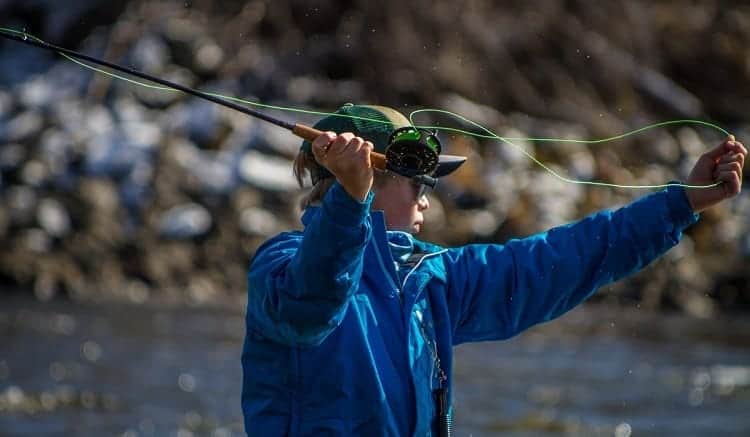
Shooting fly fishing lines can cast large flies like a rocket.
Large or heavy flies and streamer patterns will go the distance with little hesitation. Shooting lines are particularly handy for casting huge distances in the surf or the sand flats.
Shooting lines are an extreme version of weight forward lines.
But in aggressive shooting lines the heavy forward portion of the line is often short in comparison at only 25-30 feet. Aggressive shooting lines provide distance at the expense of finesse.
Other shooting designs stretch the front taper out to around 40 feet in hopes to achieve a more gentle presentation. In either case, the heavy front taper is a vital characteristic when a long cast is needed.
When limited space to backcast is an issue then the Shooting line can provide maximum distance with minimal false casting.
Shooting heads will help you to bomb a heavy Clouser Minnow to those blitzing striped bass, or cast a shrimp pattern 80 feet to a stalking bonefish. Shooting head-style fly lines come in floating and sinking varieties.
References:


